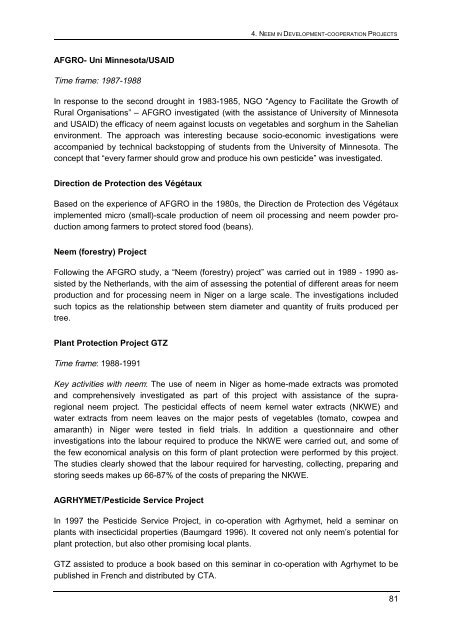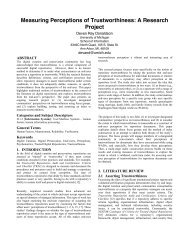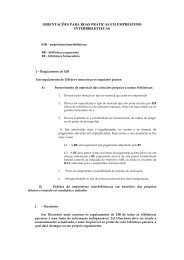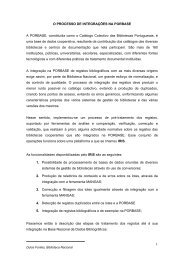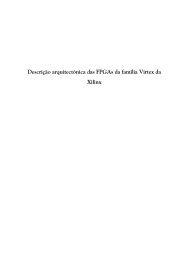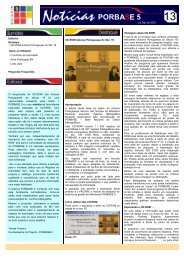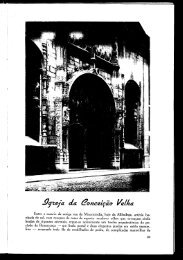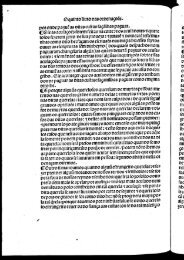Status report on global Neem usage - Biblioteca Nacional de Portugal
Status report on global Neem usage - Biblioteca Nacional de Portugal
Status report on global Neem usage - Biblioteca Nacional de Portugal
You also want an ePaper? Increase the reach of your titles
YUMPU automatically turns print PDFs into web optimized ePapers that Google loves.
AFGRO- Uni Minnesota/USAID<br />
Time frame: 1987-1988<br />
4. NEEM IN DEVELOPMENT-COOPERATION PROJECTS<br />
In resp<strong>on</strong>se to the sec<strong>on</strong>d drought in 1983-1985, NGO “Agency to Facilitate the Growth of<br />
Rural Organisati<strong>on</strong>s” – AFGRO investigated (with the assistance of University of Minnesota<br />
and USAID) the efficacy of neem against locusts <strong>on</strong> vegetables and sorghum in the Sahelian<br />
envir<strong>on</strong>ment. The approach was interesting because socio-ec<strong>on</strong>omic investigati<strong>on</strong>s were<br />
accompanied by technical backstopping of stu<strong>de</strong>nts from the University of Minnesota. The<br />
c<strong>on</strong>cept that “every farmer should grow and produce his own pestici<strong>de</strong>” was investigated.<br />
Directi<strong>on</strong> <strong>de</strong> Protecti<strong>on</strong> <strong>de</strong>s Végétaux<br />
Based <strong>on</strong> the experience of AFGRO in the 1980s, the Directi<strong>on</strong> <strong>de</strong> Protecti<strong>on</strong> <strong>de</strong>s Végétaux<br />
implemented micro (small)-scale producti<strong>on</strong> of neem oil processing and neem pow<strong>de</strong>r producti<strong>on</strong><br />
am<strong>on</strong>g farmers to protect stored food (beans).<br />
<strong>Neem</strong> (forestry) Project<br />
Following the AFGRO study, a “<strong>Neem</strong> (forestry) project” was carried out in 1989 - 1990 assisted<br />
by the Netherlands, with the aim of assessing the potential of different areas for neem<br />
producti<strong>on</strong> and for processing neem in Niger <strong>on</strong> a large scale. The investigati<strong>on</strong>s inclu<strong>de</strong>d<br />
such topics as the relati<strong>on</strong>ship between stem diameter and quantity of fruits produced per<br />
tree.<br />
Plant Protecti<strong>on</strong> Project GTZ<br />
Time frame: 1988-1991<br />
Key activities with neem: The use of neem in Niger as home-ma<strong>de</strong> extracts was promoted<br />
and comprehensively investigated as part of this project with assistance of the supraregi<strong>on</strong>al<br />
neem project. The pesticidal effects of neem kernel water extracts (NKWE) and<br />
water extracts from neem leaves <strong>on</strong> the major pests of vegetables (tomato, cowpea and<br />
amaranth) in Niger were tested in field trials. In additi<strong>on</strong> a questi<strong>on</strong>naire and other<br />
investigati<strong>on</strong>s into the labour required to produce the NKWE were carried out, and some of<br />
the few ec<strong>on</strong>omical analysis <strong>on</strong> this form of plant protecti<strong>on</strong> were performed by this project.<br />
The studies clearly showed that the labour required for harvesting, collecting, preparing and<br />
storing seeds makes up 66-87% of the costs of preparing the NKWE.<br />
AGRHYMET/Pestici<strong>de</strong> Service Project<br />
In 1997 the Pestici<strong>de</strong> Service Project, in co-operati<strong>on</strong> with Agrhymet, held a seminar <strong>on</strong><br />
plants with insecticidal properties (Baumgard 1996). It covered not <strong>on</strong>ly neem’s potential for<br />
plant protecti<strong>on</strong>, but also other promising local plants.<br />
GTZ assisted to produce a book based <strong>on</strong> this seminar in co-operati<strong>on</strong> with Agrhymet to be<br />
published in French and distributed by CTA.<br />
81


